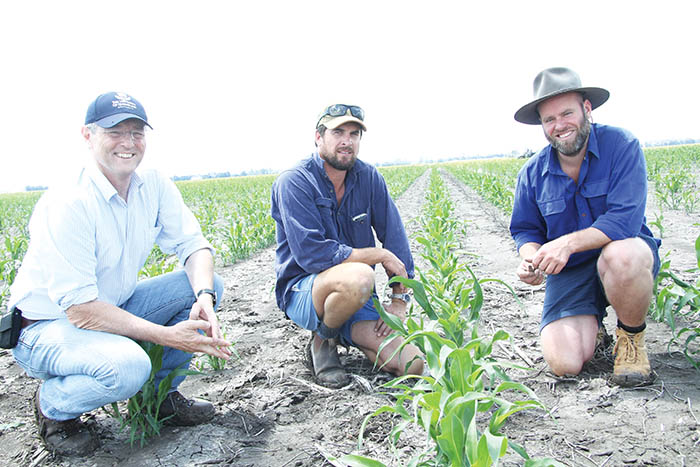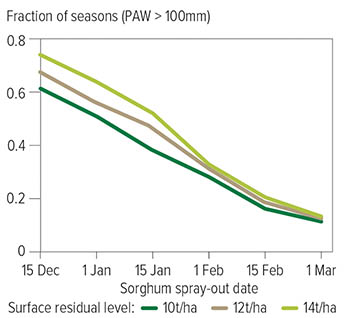Growers and researchers are looking at the viability of planting sorghum early to minimise the crop’s chance of running into yield-depleting heatwaves at flowering
The sowing of sorghum in winter as a way to avoid heatwaves at flowering is being explored in a GRDC-invested project, and results from the first year of trials point to the practice’s potential to deliver benefits for crops and cropping systems.
Led by QAAFI's Centre for Crop Science, the project has come at a time when sorghum growers are looking for ways to avoid heatwaves around flowering that are limiting yields in what for many is their main cash crop.

“Water stress and heatwaves are increasingly limiting summer cereal production across GRDC’s northern region,”
UQ principal research fellow Associate Professor Daniel Rodriguez says.
“This project is looking into that narrow window of opportunity that exists to plant a summer cereal crop into soil moisture in August, because early sowing of crops is likely to reduce the likelihood of them flowering during heatwaves.”
The project’s first trials were sown at Breeza, Mallawa and Gurley, in NSW, Mount Moriah and Warra, in southern Queensland, from August to November in 2017, and Emerald, in Central Queensland, in 2018.
“Preliminary results suggest that heatwaves can be avoided and high yields of sorghum can be achieved with winter-sown sorghum,” says Associate Professor Rodriguez. UQ modelling and climate analyses, coupled with preliminary trial results, have identified the ideal flowering window in NSW and Queensland as falling within October–November and March–April.
While Central Queensland crops often flower in the autumn window, most crops in NSW and southern Queensland flower in the middle of summer, which project officer Joseph Eyre says exposes them to a high risk of heatwaves.
“To catch the spring window, sorghum should be sown into suboptimal soil temperatures of around 12°C in July–August.”

System Fit
Early sowing means early harvest and Associate Professor Rodriguez says this allows soil-water reserves to recharge on storm rain over January–February prior to planting with a winter crop after a short fallow.
“It works better for double-cropping, because waiting for subsoil moisture to recharge for the following winter crop holds with it an opportunity cost to the grower.
“A later-planted winter crop is more likely to run into heat stress at flowering, and the bigger opportunity cost is not being able to double-crop at all over winter if growers don’t get enough rain in the fallow period.”
Associate Professor Rodriguez says APSIM (Agricultural Production Systems sIMulator) and climate modelling done within the project show early sowing allows the crop to be harvested before mid-December, offering an 80 per cent probability for double-cropping with chickpeas.
This compares to a 20 per cent probability for a November sowing.
Downs Experience
Trial results so far indicate sorghum crops could be sown in winter if soil temperatures at sowing depth are 12°C to 14°C and rising.
The Warra site had three sowing dates in 2017: 5 August, 11 October and 1 November, and the August sowing experienced 10 bouts of a minimum ambient temperature at the canopy level of less than 2°C between emergence and the three-expanded leaves.
“If sown into moist soil, apart from a longer time to emergence and some leaf redness, there was no damage to the foliage, and the yield was not affected by sowing date at any site.”
The early-sown crop took about 100 days to 50 per cent flowering, compared with 70 days for the October planting and about 60 days for the November one.
Benefits For Winter Crop
Warra grower Daniel Wegener is one of a handful of growers who is experimenting with planting sorghum early, and sowed some of the family’s 2017 and 2018 crops in August.
They yielded at least 10 per cent above the crops planted in the traditional October window.
“Early sowing has the potential to avoid some of that lodging you get with October planting, if the crop has a soft start and a tough finish, and goes through stress periods post flowering,” Mr Wegener says.
The Wegeners’ Commander barley planted in May 2018 into early sorghum stubble yielded 3 tonnes per hectare, which Mr Wegener says is a pleasant surprise given the dryness of the growing season.
“We got 12 millimetres of rain in early May just before we planted, and we went deeper than we normally would at 10 centimetres to access subsoil moisture, which is what made the crop.
“During the growing season, the only rain it got was 25mm at the end of June and then 14mm at the end of July, so we thought we might get 2.4t/ha if we were lucky.
“Having stubble from a sorghum crop that finishes in January seems to help the soil collect moisture from the storms we get in January and February.”
Mr Wegener says early sorghum also makes for easier management in a double-cropping system.
“Instead of planting and harvesting at the same time, we can aim to have all the sorghum in by September and get into our winter-crop harvest in October.”
Looking Ahead
The project will initially evaluate commercial hybrids of contrasting maturity, tillering and stay-green grown over this and next summer. Sowing times will initially target two early and one conventional control, which mirrors growers’ practised sowing date.
This summer, trials have been sown in early August, September and October in NSW and southern Queensland, and June, October and February in Central Queensland.
Rainfed and irrigation treatments are being included at the three core trial sites of Breeza, Emerald and Warra.
Research contact: Professor Daniel Rodriguez, 0434 075 094 or d.rodriguez@uq.edu.au
or Dr Joseph Eyre, 0467 737 237, j.eyre@uq.edu.au
Original article published in GRDC Ground Cover, February 2019, by Liz Wells “Early sorghum widens window of opportunity", https://grdc.com.au/resources-and-publications/groundcover/groundcover-138-january-february-2019/growers,-researchers-explore-sorghum-winter-start
This research project is funded by GRDC project code: UOQ1808



